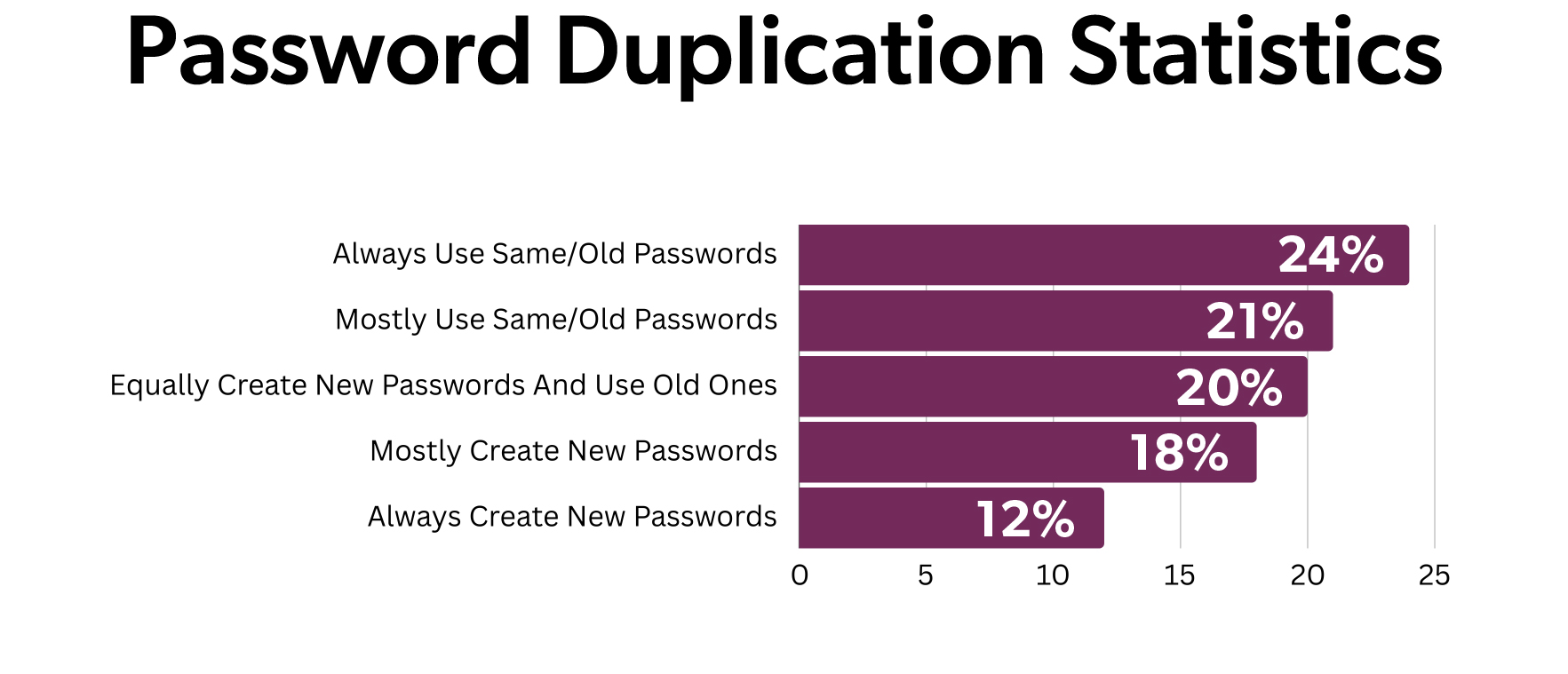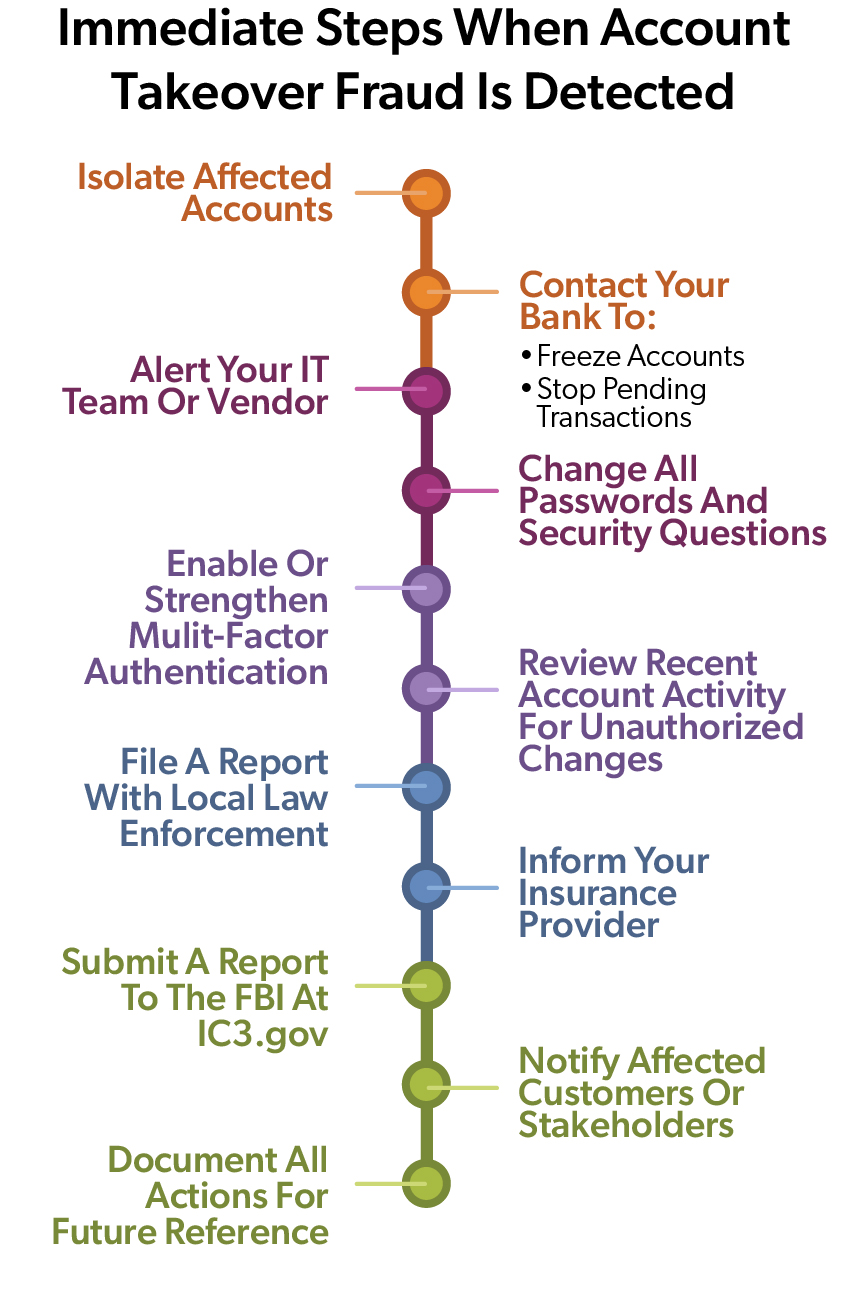Account takeover fraud, when a hacker gets into one of your online accounts, is a significant threat to people, organizations, and businesses. In fact, recent data shows that 29% of people, or about 77 million adults, have experienced account takeover fraud. The personal behaviors that can lead to account takeover directly impact businesses, as both employees and customers can unknowingly bring risks into the corporate environment.
Understanding how account takeover fraud happens and implementing effective account takeover prevention strategies is the first step to protect your company's reputation, sensitive information, and financial assets.
What Is Account Takeover Fraud?
Account takeover fraud occurs when criminals gain unauthorized access to a user's account, often through stolen login credentials or social engineering tactics. When they gain control of an account, they can cause extensive damage to your business's finances and reputation.
When hackers access online banking accounts, the stakes are high. Account takeover fraud can lead to:
- Fraudulent payments & transfers
- Reputational damage
- Operational disruptions
- Identity theft
Business Email Compromise (BEC) is a type of account takeover fraud involving criminals accessing work email accounts. This extremely common account takeover fraud allows hackers to:
- Use legitimate email accounts to impersonate executives or finance department employees
- Initiate fake financial transactions
- Redirect legitimate payments to criminal-controlled accounts
- Access sensitive company information
Financial account takeover fraud is different from other types of fraud because of the potential for criminals to cause significant damage over the long term. Unlike isolated incidents, such as a single instance of wire transfer fraud, financial account takeover fraud sometimes continues over a long period of time if it goes undetected. This extended access can lead to sizable financial losses and prolonged identity theft issues.
While financial accounts remain primary targets, cybercriminals also exploit vulnerabilities in corporate cloud storage, employee credentials for government services, company social media profiles, and even business-related subscription services. Social media account takeovers are particularly concerning for businesses and organizations, as they can severely damage brand reputation, erode customer trust, and lead to significant financial and operational consequences.
How Does Account Takeover Fraud Happen?
An important part of account takeover fraud prevention is learning how criminals most often access online accounts, whether business or personal. By understanding their methods, you can work with your IT department to strengthen your prevention strategies and reduce the risk of account takeover fraud at your business.
- Phishing and Social Engineering: One recent study shows that 74% of account takeover attacks begin with phishing. Criminals use misleading emails, phone calls, texts, or social media to trick people into giving them their login credentials or sensitive information. The hackers often pretend to be trusted people, like bank employees, executives, or vendors.
- Credential Stuffing: Every time you make a new account online, you typically have a login username and a password. And every time there’s a data breach involving stolen usernames and passwords, criminals often try to use them to log in to other accounts, sometimes leveraging automated tools to test large numbers of credentials quickly. Unfortunately, many people reuse passwords across multiple accounts, which leaves them vulnerable to account takeover fraud. In fact, only about 12% of adults report making a new, unique password for each account.

- Malware and Keyloggers: Harmful software programs can get onto your phone, tablet, or computer when you click on links in phishing emails, download suspicious attachments, visit compromised websites, or connect to unsecured public Wi-Fi. Once installed, these programs secretly gather login information and other sensitive data.
- Security Gaps: Weak organizational cybersecurity practices often make accounts vulnerable. These may include weak password policies, lack of multi-factor authentication, outdated software, or insufficient employee training on cybersecurity best practices.
What Are Common Signs of Account Takeover Fraud?
Signs that hackers accessed an account will vary by the type of account, but these are some of the most common symptoms of potential account takeover attempts. Pay close attention to anything out of the ordinary.
- Unusual account activity. Watch for unusual account activity like several failed login attempt alerts, transactions that deviate from normal patterns, or logins from unfamiliar locations.
- Alerts from your bank. Financial institutions play a crucial role in detection. They may send alerts about large or out-of-pattern transactions, login attempts from new locations, or changes to account details. Take these notifications seriously and respond promptly.
- Client feedback. Customer complaints can also signal potential fraud. Make sure to investigate further if your customers report unauthorized transactions, difficulty accessing their accounts with you, or unexpected changes to their account information.
How Do Businesses Prevent Account Takeover?
Your business has a duty to implement strong account takeover prevention strategies to reduce the risk of account takeover fraud. Ignoring these can result in major financial losses, damage to your organization’s reputation, and possible legal liability. Prevent account takeover by implementing the following strategies:
- Strong Password Policies: Require your employees to use complex passwords and require ongoing, regular password changes. Do not allow employees to reuse passwords across accounts and encourage them to use password managers to keep track of unique passwords.
- Use Multi-Factor Authentication (MFA): Implement MFA for all accounts, especially those with sensitive information, like online banking. Multi-factor authentication requires a second verification after logging in, such as a code you receive via text, email, or phone call. Consider using biometric authentication or hardware tokens for enhanced security.
- Educate Employees Regularly: Implement a continuous training program to teach your staff to recognize phishing attempts and social engineering tactics. Running simulated phishing campaigns can help reinforce this training.
- Update Software Promptly: Work with your IT department or vendor to regularly update all software, including operating systems, applications, and security software. Apply security patches right away when they're released to reduce risks.
- Monitor Accounts: Reconcile bank accounts daily to promptly catch any unauthorized payments. Work with your bank to implement fraud prevention tools and alerts for unusual account activities.
- Limit Access To Accounts: Only allow employees access to accounts and sensitive information that they need to perform their jobs. Regularly review who can access accounts, especially when employees change roles or leave. Train new employees rigorously on security protocols.
- Upgrade Network Security: Work with your IT department or vendor to implement firewalls and encryption to protect data. Conduct regular security audits and penetration testing. Use network segmentation and VPNs for remote access.
- Review Incident Response Plans: Develop plans to respond to account takeover fraud. Document steps to take, who to contact, and regularly update and test the plan, ensuring all staff members understand their responsibilities.
Steps to Take When Account Takeover Fraud Occurs
Despite your best efforts to prevent it, account takeover fraud can still happen, and knowing what to do is the first step to fixing it. Criminals often go to great lengths to hide their fraud, including redirecting alerts and notifications to minimize account takeover fraud detection, which means businesses need to be on guard and prepared to act quickly when they suspect fraud. Here are some steps to take:

- Act Immediately: Isolate the accounts that are affected and work with your bank to freeze accounts and stop pending transactions. Alert your IT team or vendor, change passwords, enable MFA, file a report with law enforcement, inform your insurance provider, and submit a report to the FBI at IC3.gov.
- Investigate the Breach: Have your IT team or a cybersecurity expert examine the breach in detail. Identify how the attackers gained access, what information was compromised, and determine the timeline of the attack. Collect and preserve evidence for potential legal action. Cybersecurity insurance may cover the cost of this investigation.
- Strengthen Security Post-Breach: Review and update security policies based on lessons learned from the investigation. Implement additional security measures and train employees, including training for the vulnerabilities exploited in the attack.
Strengthening your account takeover fraud prevention strategy is an ongoing process that must evolve with the shifting tactics of cybercriminals. By staying informed about emerging threats, regularly updating your security measures in collaboration with your bank, and fostering a culture of security awareness within your organization, you'll be better equipped to minimize the risk of account takeover fraud and mitigate potential damages.





